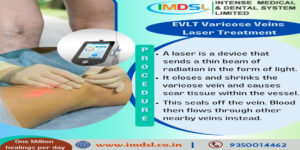Transforming Varicose Veins Treatment: The Power of Laser Therapy
Varicose veins can be a source of discomfort, pain, and aesthetic concerns for many individuals. Fortunately, advancements in medical technology have led to the development of innovative treatment options, including laser therapy.
In this blog, we will delve into the transformative power of laser therapy for varicose veins and explore how this cutting-edge approach is revolutionizing the field of vascular medicine.

Understanding Varicose Veins
Varicose veins are enlarged, twisted veins that typically occur in the legs. They develop when valves in the veins become weakened or damaged, causing blood to pool and veins to bulge. This condition can result in symptoms such as pain, heaviness, swelling, and cosmetic concerns.
The Rise of Laser Therapy
Laser therapy has emerged as a highly effective treatment option for varicose veins. Among the various laser options available, the 1470 nm laser has gained significant popularity due to its unique properties and advantages.
The 1470 nm Laser
An Advanced Treatment Modality: The 1470 nm laser with a radial fiber has revolutionized the field of varicose vein treatment. Its radial emission pattern enables a wider coverage area, minimizing the risk of complications during the procedure. This laser’s wavelength has a higher affinity for water than hemoglobin, allowing it to precisely target the water content in the vein wall.
Advantages of Laser Therapy for Varicose Veins:
Compared to other treatment options, laser therapy offers several advantages. It requires less energy to achieve adequate ablation of the vein, resulting in reduced treatment time and enhanced patient comfort. Laser therapy is also associated with fewer injuries to neighboring structures, leading to lower rates of postoperative complications.
How Laser Therapy Works
Laser therapy utilizes targeted energy emission to heat the vein wall without the need for direct radiation. As the 1470 nm laser interacts with water molecules in the vein, it generates steam bubbles that heat the vein wall, causing it to collapse and seal shut. This process is known as endovenous ablation.
Targeted Energy Emission
Heating the Vein Wall: The 1470 nm laser’s radial fiber emits energy in a radial pattern, allowing it to cover a larger area of the vein wall. By precisely targeting the water content in the vein wall, the laser generates steam bubbles that heat and collapse the vein, effectively treating the varicose vein.
Minimal Invasiveness and Faster Recovery
Laser therapy is a minimally invasive procedure that can be performed on an outpatient basis. Since it involves heating the vein wall rather than surgical removal, it results in minimal scarring and a faster recovery time. Patients can typically resume their daily activities more quickly compared to traditional surgical treatments.
A Comparative Analysis
1470 nm Laser vs. Other Options
Studies have compared the effectiveness of the 1470 nm radial fiber laser with other laser wavelengths, such as the 980 nm laser. The results have highlighted the unique advantages of the 1470 nm laser for varicose vein treatment.
Reduced Energy Requirement and Enhanced Ablation
The 1470 nm laser requires less energy to achieve adequate vein ablation compared to the 980 nm laser. This means shorter procedure times and improved patient comfort during the treatment. The laser’s targeted energy emission ensures precise and effective vein closure.
Lower Risk of Complications and Injuries
Another significant benefit of the 1470 nm laser is its reduced risk of complications and injuries to neighboring structures. The laser’s radial emission pattern enables a safer treatment experience, minimizing the chances of adverse events and postoperative complications.
The Role of Surgeons and Physiotherapists in Laser Treatment
Both Surgeons and Physiotherapists play vital roles in the administration of laser therapy for varicose veins. Surgeons are responsible for performing the procedure, utilizing their surgical expertise and precision to deliver optimal results. Physiotherapists complement the treatment by providing postoperative care, guidance, and specialized exercises to support patient recovery and long-term vein health.
Patient Experience and Success Rates
Laser therapy has demonstrated impressive success rates in treating varicose veins. Patients who undergo laser treatment experience reduced pain, improved symptoms, and a significant improvement in the appearance of their veins. The minimally invasive nature of laser therapy contributes to higher patient satisfaction and a faster return to daily activities.
Embracing Laser Therapy
Benefits for Surgeons and Physiotherapists: For Surgeons and Physiotherapists, incorporating laser therapy into their practice offers numerous benefits. By offering this advanced treatment modality, practitioners can expand their services, attract more patients, and stay at the forefront of medical innovation. Additionally, the minimally invasive nature of laser therapy contributes to improved patient outcomes, satisfaction, and overall practice success.
Laser therapy with the 1470 nm laser is transforming the landscape of varicose vein treatment. With its targeted energy emission, minimal invasiveness, and faster recovery times, laser therapy offers an effective and patient-friendly alternative to traditional surgical interventions. Surgeons and Physiotherapists equipped with this advanced technology can deliver outstanding results and positively impact the lives of varicose vein patients, improving their quality of life and restoring confidence.
By embracing laser therapy, healthcare professionals can embark on a journey of innovation, patient satisfaction, and enhanced practice success in the dynamic field of varicose vein treatment.


Comments